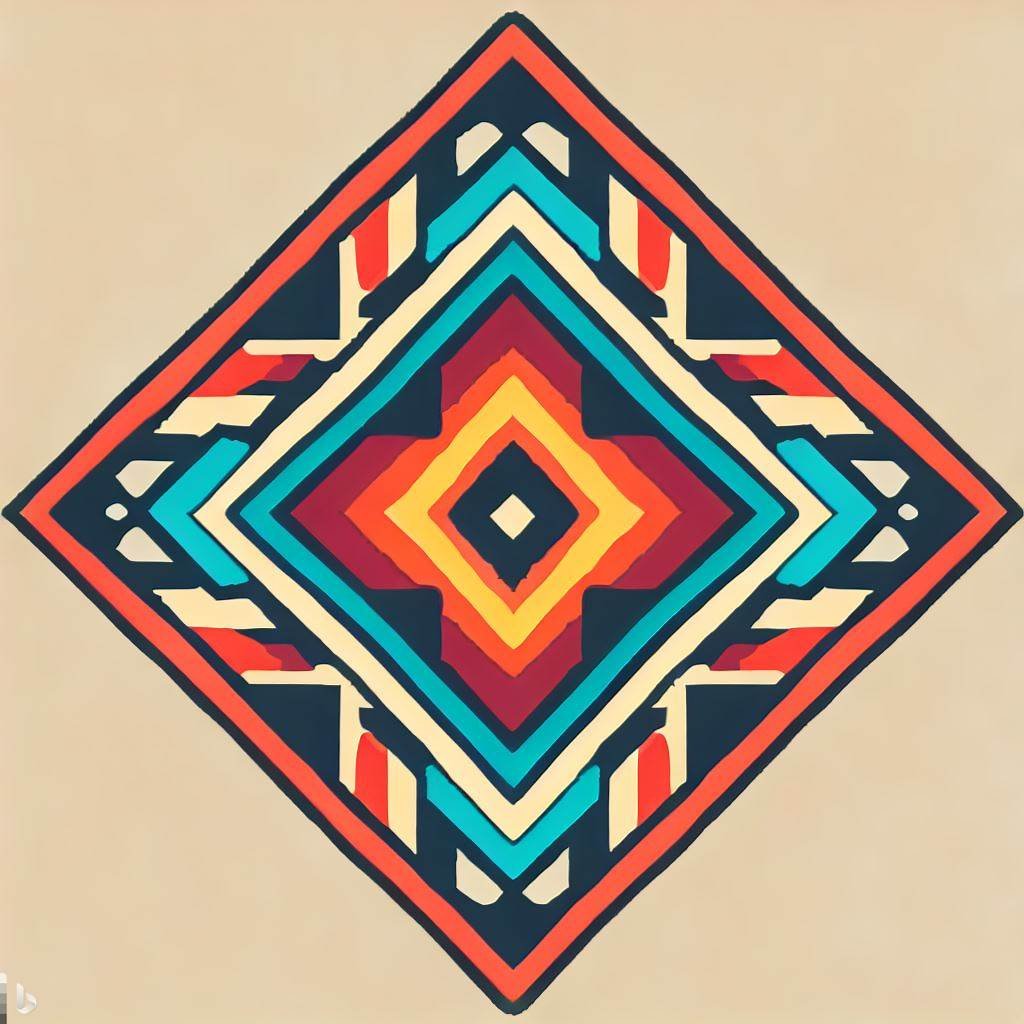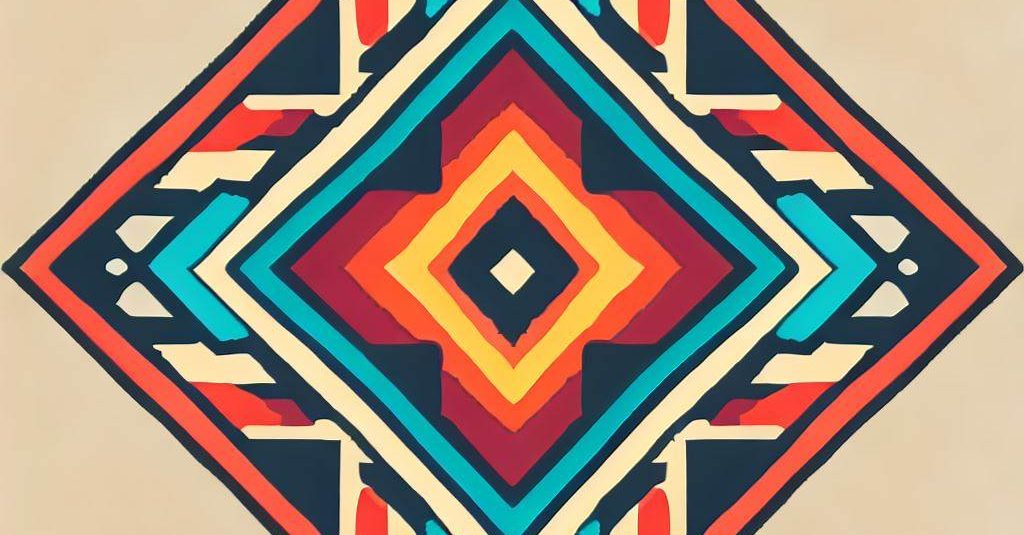Navajo Sandpainting: A Sacred Art Form Interwoven with Tradition and Cultural Exchange
Navajo sandpainting is a sacred and intricate art form that holds deep spiritual significance within the Navajo culture. This ancient practice, also known as iikááh, or “place where the gods come and go,” involves the creation of elaborate designs using naturally colored sand, charcoal, and ground minerals. Navajo sandpaintings are not only visually stunning, but they also serve as an essential component of Navajo religious ceremonies and healing rituals. This article will explore the history, techniques, and cultural importance of Navajo sandpainting while highlighting the interactions with other tribes and peoples that have contributed to the evolution of this unique art form.
The Origins and Early History of Navajo Sandpainting:
The precise origins of Navajo sandpainting remain a subject of debate among scholars, with some suggesting that the practice may have been adopted from the Pueblo tribes, who also have a tradition of creating intricate artwork using natural pigments. Others argue that sandpainting may have been independently developed by the Navajo, given the tribe’s deep spiritual connection to the natural world and the central role that sandpaintings play in Navajo ceremonies.
Regardless of its origins, sandpainting has long been an essential aspect of Navajo religious life, with early sandpaintings likely used in healing ceremonies, rites of passage, and other spiritual observances. As the Navajo culture evolved and interacted with other tribes and peoples, sandpainting techniques and designs became more elaborate and refined, reflecting the dynamic nature of Navajo spirituality and artistic expression.
Techniques and Materials:
Navajo sandpaintings are created using a variety of naturally colored sands and minerals, which are carefully ground and sifted to achieve the desired consistency and hue. Common materials used in sandpaintings include red sandstone, white gypsum, yellow ochre, and black charcoal. These natural pigments are then applied to a prepared surface, typically a smoothed layer of sand or a cloth, using the artist’s fingers or small tools to create intricate designs and patterns.
The process of creating a sandpainting is meticulous and time-consuming, often taking several hours or even days to complete. The artist must carefully select and mix the appropriate colors, and the design must be executed with precision and symmetry. In many cases, sandpaintings are created by a group of artists or family members working together, reflecting the communal nature of Navajo spiritual practices.
Navajo Sandpainting Techniques and Materials

Naturally colored sands and minerals
Red sandstone, white gypsum, yellow ochre, black charcoal
Fingers or small tools for application
Ceremonial and Spiritual Significance:
Navajo sandpaintings serve a vital function in the tribe’s religious ceremonies, particularly in healing rituals known as “chantways.” These ceremonies are conducted by a medicine man or hatałii, who leads the patient and their family through a series of prayers, songs, and rituals intended to restore balance and harmony to the individual’s life.
The sandpainting is a central component of the chantway, as it is believed to act as a conduit between the earthly realm and the spiritual world. The intricate designs and symbols depicted in the sandpainting often represent Navajo deities or Holy People, as well as elements from the tribe’s creation myths and spiritual beliefs. By creating a sandpainting, the hatałii is effectively inviting the Holy People to participate in the healing ceremony, providing their blessings and guidance to the patient.
Once the ceremony is complete, the sandpainting is ceremonially destroyed, as it is considered too powerful to be left intact. The sand is typically returned to the earth or dispersed in a sacred manner, emphasizing the transient nature of the artwork and the impermanence of life itself.
Influence of Other Tribes and Cultures:
The development and evolution of Navajo sandpainting have been influenced by the tribe’s interactions with other Native American peoples and cultures. As mentioned earlier, there is a possibility that the Navajo may have adopted sandpainting techniques from the Pueblo tribes, who have their own tradition of creating artwork with natural pigments.
Additionally, the Navajo have had contact with various tribes, such as the Apache, Ute, and Hopi, throughout their history. These interactions have likely contributed to the exchange of artistic styles, techniques, and spiritual beliefs, which have in turn shaped the development of Navajo sandpainting.
Preservation and Continuation of Sandpainting Tradition:
In recent years, efforts have been made to preserve and promote the traditional art of Navajo sandpainting. While sandpaintings created for religious ceremonies are considered sacred and not meant for public display, many Navajo artists have adapted the techniques and designs of sandpainting to create secular artworks that can be exhibited and sold. These contemporary sandpaintings often draw upon traditional Navajo symbolism and themes, while also incorporating modern materials and artistic styles.
By creating secular sandpaintings, Navajo artists are not only preserving their cultural heritage but also promoting a greater understanding of Navajo history and spirituality among non-Native audiences. At the same time, the continuation of the traditional sandpainting practice within the Navajo community ensures that the spiritual and cultural significance of this unique art form is passed down to future generations.
Conclusion:
Navajo sandpainting is a deeply spiritual and visually stunning art form that has been shaped by the tribe’s history, cultural exchanges, and interactions with other Native American peoples. The practice of creating sandpaintings for religious ceremonies remains an essential aspect of Navajo spiritual life, while contemporary adaptations of the art form help preserve and promote Navajo culture and heritage. By understanding and appreciating the rich history and cultural significance of Navajo sandpainting, we can foster a greater understanding of the interconnected histories, cultures, and experiences of Native American peoples.
Key Sources Consulted:
- Bahti, Tom, and Mark Bahti. “Southwestern Indian Ceremonials.” KC Publications, 2002.
- Faris, James C. “The Nightway: A History and a History of Documentation of a Navajo Ceremonial.” University of New Mexico Press, 1990.
- Newcomb, Franc Johnson. “Hosteen Klah: Navajo Medicine Man and Sand Painter.” University of Oklahoma Press, 1964.
- Reichard, Gladys A. “Navajo Medicine Man: Sandpaintings and Legends of Miguelito.” Dover Publications, 1990.
- Wyman, Leland C. “Beautyway: A Navajo Ceremonial.” Museum of Navajo Ceremonial Art, 1957.

